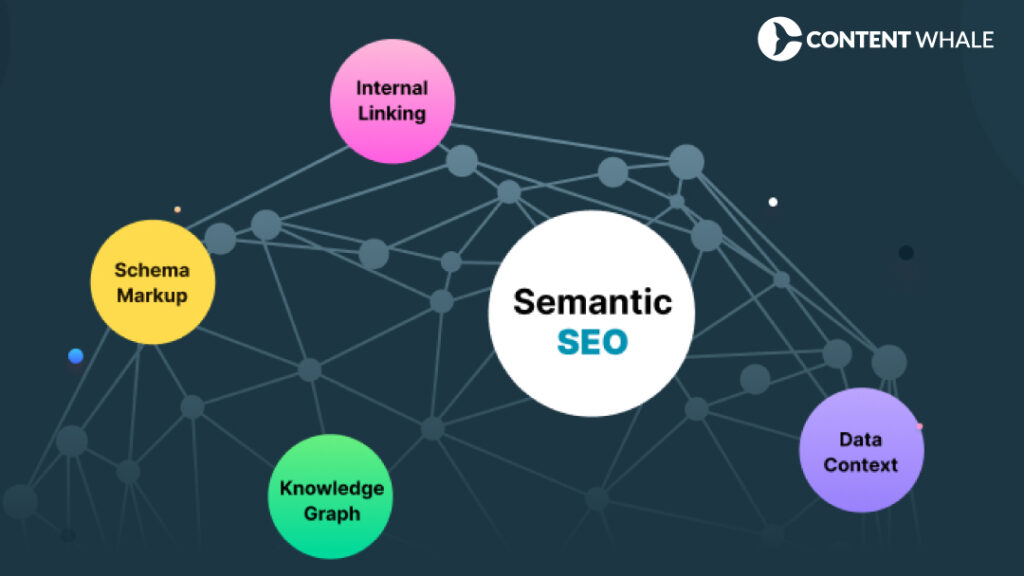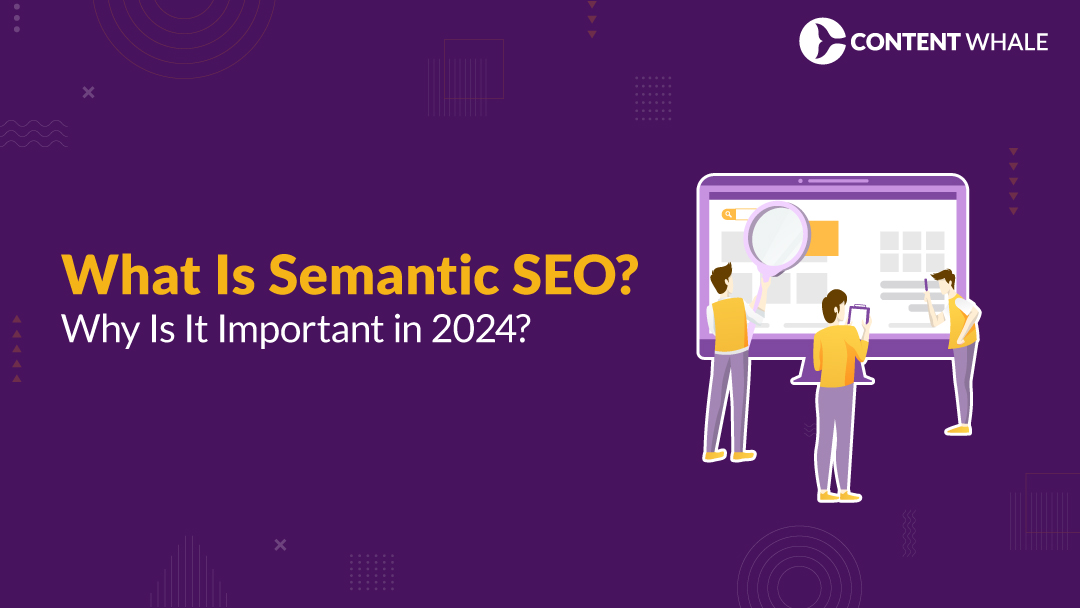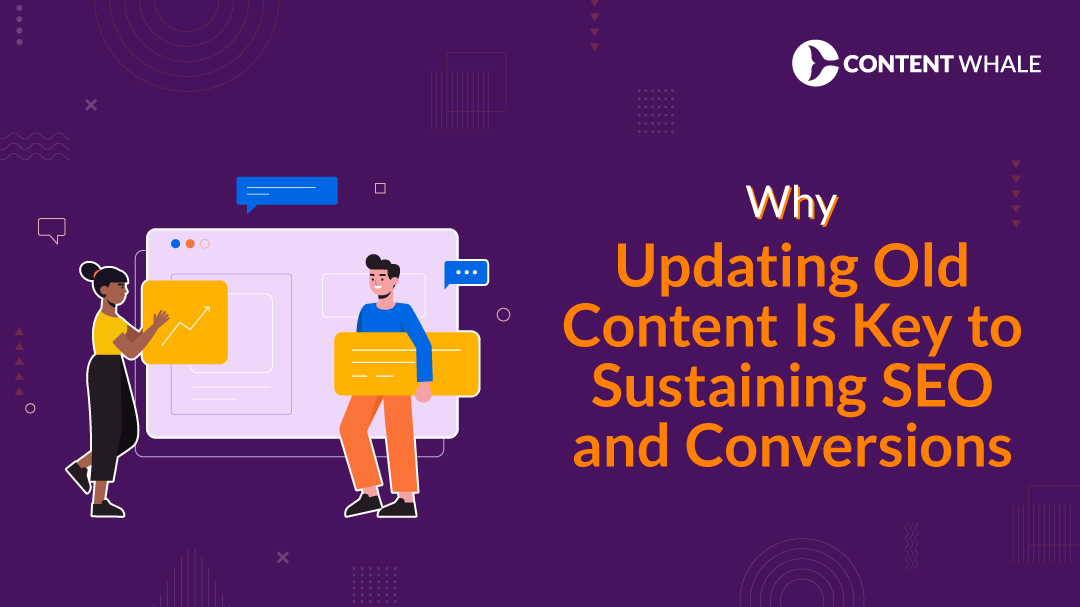Semantic SEO is a search engine optimization strategy that focuses on the meaning and context of words, phrases, and entities on a website rather than just on specific keywords. Semantic SEO helps search engines deliver more relevant and accurate results by understanding the intent and context of a user’s search query.
Semantic SEO also leverages technologies like artificial intelligence, natural language processing, machine learning, and latent semantic indexing to recognize the relationships between words and entities, offering a more holistic approach to content optimization.
In this blog, we will answer some common questions about semantic SEO, such as:
- What is semantic SEO?
- Why is semantic SEO important?
- How to do semantic SEO?
What is Semantic SEO?

Semantic SEO is a way of optimizing your website for the meaning and context of your content rather than just for specific keywords. Semantic SEO aims to provide the best possible answer to a user’s search query by understanding the intent and context behind it.
For example, if a user searches for “apple”, semantic SEO will try to determine whether the user is looking for the fruit, the company, the music label, or something else based on the context of the query and the user’s location, device, history, etc. Semantic SEO will then provide the most relevant and accurate results for the user’s query, such as apple recipes, apple products, apple news, etc.
Semantic SEO is not a new concept, but it has become more important in recent years as search engines have evolved to provide more personalized and conversational search experiences. Some of the factors that have contributed to the rise of semantic SEO are:
1. The Hummingbird Update
In 2013, Google launched the Hummingbird update, which was a major overhaul of its search algorithm. The Hummingbird update aimed to improve the quality and relevance of search results by focusing more on the meaning and context of a query rather than just on the individual keywords. The Hummingbird update also introduced the concept of “conversational search”, which allows users to ask natural language questions and get direct answers from Google.
2. The Knowledge Graph
In 2012, Google introduced the Knowledge Graph, which is a database of facts, entities, and relationships that Google uses to enhance its search results. The Knowledge Graph helps Google understand the meaning and context of a query and provides rich and interactive information, such as images, videos, maps, reviews, ratings, etc. The Knowledge Graph also powers the “featured snippets”, and the “People Also Ask” boxes, which are prominent features of semantic SEO.
3. The RankBrain Update
In 2015, Google announced the RankBrain update, which is a machine learning system that helps Google process and rank search results. RankBrain helps Google understand the meaning and context of complex and ambiguous queries and provide the best possible results. RankBrain also learns from user feedback, such as clicks, dwell time, bounce rate, etc., and adjusts the search results accordingly.
Why is semantic SEO important?

Semantic SEO is important because it can help you rank higher in search engine results, improve user experience, and increase organic traffic. Some of the benefits of semantic SEO are:
1. Higher Rankings
Semantic SEO can help you rank higher in search engine results by providing the best possible answer to a user’s query. Semantic SEO can also help you rank for long-tail keywords, which are more specific and less competitive than short-tail keywords. Long-tail keywords can also drive more qualified and targeted traffic to your website, as they indicate a higher level of user intent and interest.
2. Improved User Experience
Semantic SEO can help you improve user experience by providing relevant and accurate information and satisfying user intent. Semantic SEO can also help you reduce bounce rate, increase dwell time, and encourage user engagement by providing rich and interactive content, such as images, videos, maps, reviews, ratings, etc. Semantic SEO can also help you build trust and authority by providing credible and authoritative sources, such as the Knowledge Graph, featured snippets, and People Also Ask boxes.
3. Increased Organic Traffic
Semantic SEO can help you increase organic traffic by attracting more users to your website and providing them with a satisfying and enjoyable search experience. Semantic SEO can also help you increase conversions by providing users with the information and solutions they are looking for and guiding them through the buyer’s journey.
How to Do Semantic SEO?

Semantic SEO is not a one-time process but a continuous and evolving practice that requires constant monitoring and optimization. Some of the best practices for semantic SEO are:
- Use the right WordPress SEO tool, such as AIOSEO, to optimize your site for semantic search. AIOSEO is a powerful and easy-to-use WordPress SEO plugin that helps you optimize your site for semantic SEO by providing features such as smart XML sitemaps, schema markup, SEO audit checklist, local SEO, WooCommerce SEO, and more.
- Create cornerstone content that covers a topic in-depth and provides comprehensive and valuable information to users. Cornerstone content is a type of long-form content that serves as the foundation of your website and showcases your expertise and authority on a topic. Cornerstone content can help you rank for multiple keywords and queries and attract more organic traffic and backlinks to your site.
- Build topic clusters that link related pages and posts together, creating a semantic network of content. Topic clusters are a way of organizing your content around a main topic and its subtopics and linking them together with internal links. Topic clusters can help you improve your site structure, boost your SEO, and provide a better user experience.
- Use LSI keywords that are semantically related to your main keyword, and avoid keyword stuffing. LSI keywords are keywords that are closely related to your main keyword and share the same context and meaning. LSI keywords can help you optimize your content for semantic SEO by providing more relevance and variety to your content and avoiding keyword stuffing and over-optimization. You can use tools like LSI Graph or AIOSEO to find LSI keywords for your content.
- Add schema markup to your content, such as JSON-LD, to help search engines understand the structure and meaning of your content. Schema markup is a type of code that you can add to your content to provide additional information and context to search engines. Schema markup can help you enhance your search results by adding rich snippets, such as images, videos, ratings, reviews, etc., and increasing your click-through rate and visibility.
- Optimize for “People Also Ask” questions, which are related queries that users may have about your topic. People Also Ask questions are a type of featured snippet that appears in search results and provides direct answers to common questions. “People Also Ask” questions can help you optimize your content for semantic SEO by providing more information and value to users and increasing your chances of ranking for multiple queries.

Semantic SEO is a fact, not a myth. It is a search engine optimization strategy that focuses on the meaning and context of words, phrases, and entities on a website rather than just on specific keywords. Semantic SEO helps search engines deliver more relevant and accurate results by understanding the intent and context of a user’s search query. Semantic SEO also leverages technologies like artificial intelligence, natural language processing, machine learning, and latent semantic indexing to recognize the relationships between words and entities, offering a more holistic approach to content optimization.
Semantic SEO is important because it can help you rank higher in search engine results, improve user experience, and increase organic traffic. Some of the best practices for semantic SEO are:
- Use the right WordPress SEO tool, such as AIOSEO, to optimize your site for semantic search.
- Create cornerstone content that covers a topic in-depth and provides comprehensive and valuable information to users.
- Build topic clusters that link related pages and posts together, creating a semantic network of content.
- Use LSI keywords that are semantically related to your main keyword, and avoid keyword stuffing.
- Add schema markup to your content, such as JSON-LD, to help search engines understand the structure and meaning of your content.
- Optimize for “People Also Ask” questions, which are related queries that users may have about your topic.
We hope this blog helped you understand what semantic SEO is and why it is important. If you have any questions or feedback, please let us know in the comments below. And don’t forget to share this blog with your friends and colleagues who might find it useful.

Q. Why has Semantic SEO become important in 2024?
A. As search engines, particularly Google, have evolved to prioritize user intent and context, Semantic SEO has grown in importance. Updates like Google’s Hummingbird, the introduction of the Knowledge Graph, and RankBrain have shifted the focus towards understanding the nuances of language and search intent, making Semantic SEO crucial for achieving higher search rankings and better user engagement.
Q. How does Semantic SEO improve user experience?
A. By focusing on the intent behind search queries and providing more accurate, contextually relevant content, Semantic SEO significantly enhances the user experience. It leads to more meaningful search results, reduces bounce rates, and increases the likelihood of users finding the exact information they need quickly and efficiently.
Q. What are the key components of a Semantic SEO strategy?
A. A comprehensive Semantic SEO strategy includes the creation of in-depth cornerstone content, development of topic clusters around main subjects, use of LSI (Latent Semantic Indexing) keywords to add context to your content, implementation of schema markup for structured data, and optimization for “People Also Ask” questions to cover related user queries.
Q. Can Semantic SEO help with long-tail keywords?
A. Yes, Semantic SEO is particularly effective for targeting long-tail keywords. By understanding and addressing the specific intent behind these more detailed queries, you can attract highly targeted traffic to your website, often with a higher intent to engage or convert.
Q. What tools can assist with Semantic SEO?
A. Tools like AIOSEO for WordPress users offer features that support Semantic SEO, including smart XML sitemaps, schema markup, and an SEO audit checklist. Other tools like LSI Graph help identify LSI keywords, and Google’s own Search Console provides insights into how your content performs in terms of user queries and engagement.
Q. How do I add schema markup to my website for Semantic SEO?
A. Schema markup can be added to a website’s HTML to help search engines understand the content’s context and structure better. You can use Google’s Structured Data Markup Helper to generate the necessary code or rely on plugins and tools designed for content management systems like WordPress, which simplify the process of adding schema to your site.





